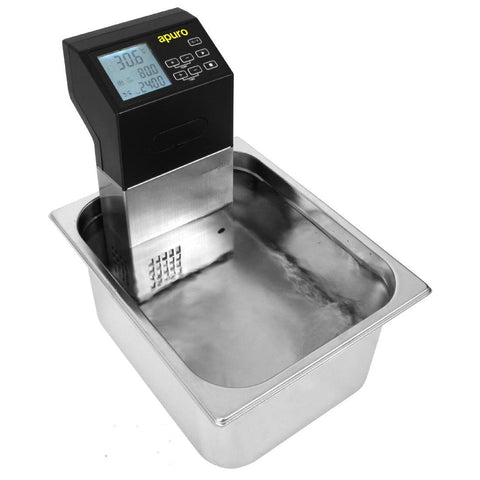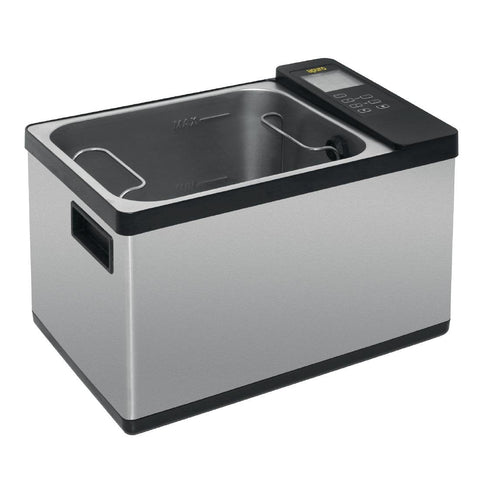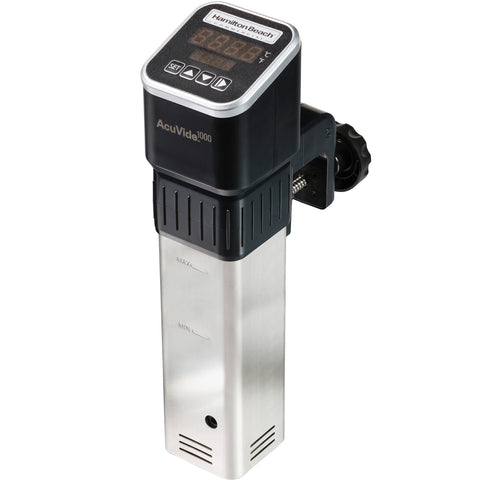
Recently Viewed


 Apuro Portable Sous Vide Machine 40Ltr
Apuro Portable Sous Vide Machine 40Ltr
163(W) x 320(H) x 130(D)mm


 Apuro Sous Vide Machine 12.5Ltr
Apuro Sous Vide Machine 12.5Ltr
415(W) x 280(H) x 265(D)mm


 Vitras SVK0320 Sous Vide Water Bath
Vitras SVK0320 Sous Vide Water Bath
350(W) x 240(H) x 280(D)mm


 Sammic Smart Vide 5 Immersion Cooker - 806711
Sammic Smart Vide 5 Immersion Cooker - 806711
130W x 330D x 170Hmm


170W x 375D x 95Hmm


 Hamilton Beach Commercial HSV1000 Sous Vide Stick Circulator
Hamilton Beach Commercial HSV1000 Sous Vide Stick Circulator
89(W) x 324(H) x 2(D)mm
Sous vide, which means "under vacuum" in French, is a culinary technique that involves vacuum-sealing ingredients and immersing them in a temperature-controlled water bath. This method guarantees consistent and delicious results, making it a popular choice in commercial kitchens. Find the perfect sous vide equipment for your kitchen in our collection.
Sous vide is a French style of cooking where vacuum-bagged food is heated to the perfect internal temperature using a water bath. It allows you to maintain the temperature of your food while it cooks to ensure you get the perfect level of doneness and taste. For example, when a customer requests their steak to be ‘medium rare’ or ‘well done’, this is a reference to the internal temperature of the steak. Medium rare is generally around 52°C-56°C and a sous vide machine will enable you to achieve this easily.
Sous vide temperatures vary depending on the dish and desired outcome. Typically, they range from 43°C for delicate proteins like fish, 53°C to 63°C for meat and approximately 85°C for cooking vegetables.
Sous vide machines are perfect for when you are preparing meat that requires long periods of cooking time or needs to be cooked at precise temperatures. This kind of machine is also ideal for preparing vegetables, poultry and fish.
There are many benefits to using sous vide machine in your commercial kitchen, including:
- Consistent results every time - Because the temperature is controlled precisely, your food will always come out tasting great.
- No risk of overcooking or undercooking - You can safely leave your meal unattended while it cooks because the machine will stop when it reaches its target temperature.
- Better taste and nutrients - As the food is vacuum-locked, it does not lose moisture or seasoning while being cooked. As a result, all of the flavour stays in place and doesn't evaporate as it does in regular open-heat cooking.
You can cook a wide range of foods, including meat, fish, vegetables, and eggs.
Embarking on the journey to find the perfect commercial sous vide for your kitchen can be an exciting yet challenging experience. To make your quest a breeze, we've gathered some key factors to keep in mind while searching for that ideal commercial sous vide machine to cater to your needs:
Absolutely! Adding fresh aromatics like herbs, spices, or citrus zest to the sous vide bag enhances flavours, elevating your culinary creations. Just remember, a little goes a long way, and you need much less than in traditional cooking as the vacuum-sealed environment intensifies the aroma.
Yes, it's important to rest your sous vide meat after cooking to allow the juices to redistribute. This will result in a juicier and more flavourful final product.
Sous Vide cooking typically takes longer than other cooking methods, as the food is cooked at a lower, more precise temperature. Cooking times can range from a few hours to over a day.
Cooking with garlic sous vide can be safe, but caution is required. Using fresh garlic can potentially introduce Clostridium botulinum bacteria, which thrive in low-oxygen environments. To minimise risk, use pre-cooked or pasteurised garlic, or switch to garlic powder or granules for a worry-free, flavourful experience.
Yes, Sous Vide cooking is safe as long as you follow best practices for food safety, such as cooking food to the appropriate temperature and maintaining a clean cooking environment.
Sous vide is so much more than just boiling! While both methods involve cooking food in water, sous vide uses precise temperature control to cook food evenly and consistently inside a vacuum-sealed bag. By sealing the ingredients in a vacuum bag and immersing them in a water bath, sous vide delivers mouthwatering results, concentrating and locking-in flavours and cooking foods to their precise doneness levels. Boiling food directly in water is a totally different style of cooking and not suitable for many types of food.
While sous vide cooking offers numerous benefits, it's essential to weigh the potential drawbacks for your business. One disadvantage is the longer cooking time, which may not suit fast-paced environments. Additionally, sous vide requires an initial investment in specialised equipment and vacuum-sealed bags. Lastly, achieving a perfect sear or crust on certain dishes after they have been sous vided may require extra steps, such as finishing the dish on a grill or stovetop. Despite these challenges, the consistent and impressive results of sous vide cooking often outweigh the disadvantages for many kitchens.
To cook Sous Vide, you need a Sous Vide machine, vacuum-sealed bags, and a container to hold the water bath.